Radiator - removal, inspection and refitting
All models except RS Turbo
Pre-1986 models
Removal
1 Drain the cooling system as described in
Chapter 1.
2 Disconnect the battery negative terminal.
3 Release the retaining clips and disconnect all the hoses from the radiator, and on vehicles with automatic transmission, disconnect and plug the oil cooler pipelines.
4 Disconnect the wiring plug at the fan motor and unclip the wiring from the shroud (see illustration).
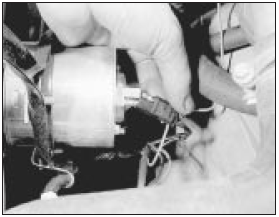
3.4 Disconnecting radiator fan wiring plug
5 Unscrew the two upper mounting bolts and carefully lift the radiator, complete with fan and cowl from the engine compartment. Note that the base of the radiator is held in place by two lugs (see illustrations).
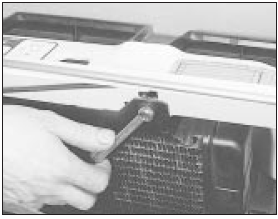
3.5a Undo the radiator upper bolts . . .
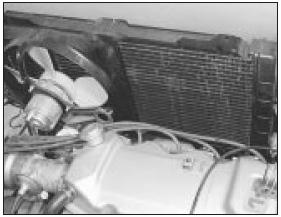
3.5b . . . and lift out the unit complete with fan - pre-1986 models (except
RS Turbo)
Inspection 6 If the purpose of removal was to thoroughly clean the radiator, first reverse flush it with a cold water hose. The normal coolant flow is from left to right (from the thermostat housing to the radiator) through the matrix and out of the opposite side.
7 If the radiator fins are clogged with flies or dirt, remove them with a soft brush or blow compressed air from the rear face of the radiator. It is recommended that the fan assembly is first removed as described in the preceding Section (if not already done). In the absence of a compressed air line, a strong jet from a water hose may provide an alternative method of cleaning.
8 If the radiator is leaking, it is recommended that a reconditioned or new one is obtained from specialists. In an emergency, minor leaks can be cured by using a radiator sealant. If the radiator, due to neglect, requires the application of chemical cleaners, then these are best used when the engine is hot and the radiator is in the vehicle. Follow the manufacturer’s instructions precisely and appreciate that there is an element of risk in the use of most de-scaling products, especially in a system which incorporates alloy and plastic materials.
Refitting
9 Refit the radiator by reversing the removal
operations, but ensure that the rubber lug
insulators are in position. Fill the cooling
system as described in Chapter 1 and on later
models adjust the alternator drivebelt as
described in Chapter 1.
1986 models onwards
Removal
10 Refer to Section 2 and remove the
radiator fan.
11 To provide greater clearance for radiator removal, slacken the alternator mounting and adjustment arm bolts and push the alternator in towards the engine as far as it will go.
12 Unscrew the two radiator lower retaining bolts (see illustration).
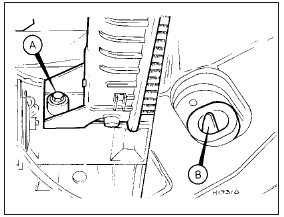
3.12 Radiator lower retaining bolts (A) and upper lugs (B) - 1986 models
onwards (except RS Turbo)
13 Move the bottom of the radiator in towards the engine, then lower it to disengage the two upper retaining lugs. Carefully lift the radiator from the engine compartment.
Inspection and refitting 14 Proceed as described previously in this Section for pre-1986 models.
RS Turbo models
1985 models
Removal
15 Drain the cooling system as described in
Chapter 1.
16 Disconnect the battery negative terminal.
17 Release the retaining clips and disconnect all the coolant hoses from the radiator.
18 Refer to Section 2 and remove the radiator fan.
19 Lift the radiator up and out of the engine compartment.
Inspection and refitting 20 Proceed as described previously in this Section for all models except RS Turbo.
1986 models onwards
Removal
21 Drain the cooling system as described in
Chapter 1.
22 Disconnect the battery negative terminal.
23 Release the retaining clips and disconnect the coolant hoses at the radiator and the air hoses at the turbo intercooler (see illustration).
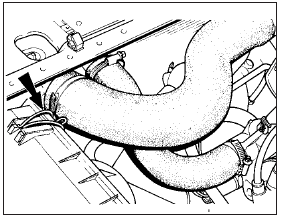
3.23 Intercooler upper air hose attachment - RS Turbo from 1986 onwards
24 Refer to Section 2 and remove the radiator fan.
25 Undo the two radiator and intercooler lower retaining bolts (see illustration).
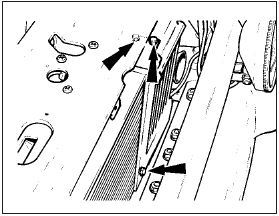
3.25 Radiator and intercooler retaining bolts - RS Turbo from 1986 onwards
(one lower bolt not shown)
26 Undo the four bolts securing the intercooler to the radiator and remove the intercooler from the front.
27 Manipulate the radiator up and out of its location from the front (see illustration).
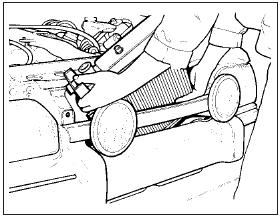
3.27 Radiator removal - RS Turbo from 1986 onwards
Inspection and refitting 28 Proceed as described previously in this Section for all models except RS Turbo.
See also:
Door window regulator - removal and refitting
Removal
1 Remove the door inner trim panel.
2 Where necessary for improved access, peel
back the waterproof plastic sheet from the
door.
3 Lower the window until the lower support
channel is vis ...
General information and precautions
General information
The fuel system comprises a centrally
mounted fuel tank, electrically-operated fuel
pump and Bosch K-Jetronic or KE-Jetronic
continuous injection system according to
model. Th ...
Ford VV carburettor manual choke unit - removal, checking and
refitting
Note: A new gasket will be required on
refitting.
Removal
1 Disconnect the battery negative lead.
2 Remove the air cleaner (Section 2).
3 Slacken the choke cable clamp bolt at the
choke lever, d ...
